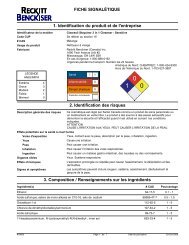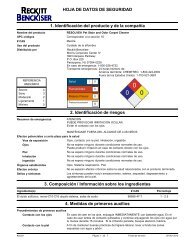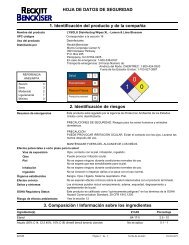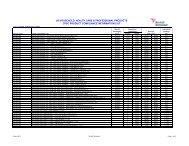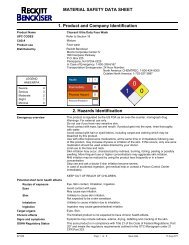Sustainability Report 2010.pdf - Reckitt Benckiser
Sustainability Report 2010.pdf - Reckitt Benckiser
Sustainability Report 2010.pdf - Reckitt Benckiser
Create successful ePaper yourself
Turn your PDF publications into a flip-book with our unique Google optimized e-Paper software.
Contents<br />
Introduction<br />
Environment<br />
Marketplace<br />
Workplace<br />
Community<br />
Managing & <strong>Report</strong>ing<br />
Carbon20 results<br />
Carbon20 is an ambitious, industry-leading programme.<br />
Nevertheless, we are already three quarters of the way towards our goal in three years!<br />
Raw & Packaging<br />
Materials<br />
Product<br />
Manufacturing<br />
and other RB operations<br />
Product<br />
Distribution<br />
Retailers<br />
Operations<br />
Consumer<br />
Use<br />
Product & Packaging<br />
Disposal/Recycling<br />
21.9% 1.5% 1.8% 2.3% 70.2% 2.3%<br />
Our Carbon20 target is a 20% reduction<br />
per Dose * in our global products’ Total Carbon<br />
Footprint by 2020, against a 2007 baseline.<br />
This is an average reduction of 1.5% each<br />
year. The split of our Total Carbon Footprint<br />
is shown above.<br />
From 2007 – 2010 we achieved an outstanding<br />
15% reduction per Dose in our products’<br />
Total Carbon Footprint. This means that<br />
after only three years we are already three<br />
quarters towards our 2020 goal.<br />
We also provided consumers with an<br />
additional 113 billion Doses in 2010<br />
versus 2007.<br />
The ‘eco-efficiency’ (see page 32) of<br />
our products’ entire lifecycle improved<br />
by 5.7% 2007 – 2010, in terms of their<br />
carbon footprint.<br />
This has been possible because the<br />
actual growth in our Total Carbon<br />
Footprint was kept to only 10%,<br />
despite a 30% growth in the actual<br />
use of our products.<br />
This suggests that we are being successful<br />
in decoupling business growth from our<br />
products’ climate change impact across<br />
their lifecycle.<br />
For further information see<br />
www.carbon20.com<br />
p5 – RB’s climate change programme<br />
Greenhouse gas emissions from the Total Carbon<br />
Footprint of RB’s global products, per Dose<br />
including<br />
Greenhouse gas<br />
acquisitions<br />
emissions from the<br />
Grammes<br />
Total Carbon<br />
of<br />
Footprint<br />
CO 2 equivalents<br />
of RB’s global products, per Dose*including acquisitions Grammes of CO2 equivalents<br />
80<br />
60<br />
40<br />
20<br />
0<br />
63.9<br />
07<br />
60.9<br />
08<br />
56.4<br />
* a Dose is the amount of each individual RB product required to deliver<br />
that product’s intended service, either for a single use or for a defined<br />
period of time eg. one Finish automatic dishwashing tablet for one<br />
load of dishwashing, the recommended number of Nurofen tablets for<br />
09<br />
54.4<br />
10<br />
Greenhouse gas emissions from the Total Carbon<br />
Footprint of RB’s global products, including<br />
acquisitions<br />
Greenhouse gas emissions<br />
Million<br />
from<br />
tonnes<br />
the Total<br />
CO<br />
Carbon 2 equivalents<br />
Footprint of RB’s global<br />
products, including acquisitions Million tonnes CO2 equivalents<br />
30<br />
24<br />
18<br />
12<br />
6<br />
0<br />
23.9<br />
07<br />
24.5<br />
08<br />
24.9<br />
24 hours of pain relief etc. In Lifecycle Assessment (LCA) terminology<br />
a Dose is the ‘functional unit’ of consumer use. The number of Doses<br />
per year is not comparable to other measures of sales or production<br />
volume used in either our financial or non-financial reporting.<br />
09<br />
26.5<br />
RB <strong>Sustainability</strong> <strong>Report</strong> 2010 5<br />
10



